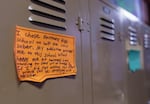Oregon teens are facing a dangerous mix of challenges — they have some of the highest rates of drug use in the country, the highest need for substance abuse programs, and yet, very limited access to support and treatment.
That’s where recovery schools come in.
Recovery schools are just like any other comprehensive high school. They teach students the basics, like math, English, science and social studies, and offer various electives. They have afterschool activities, too, and their goal is to get students to the finish line to earn their diplomas.
What sets them apart is that they’re specifically designed for students who are recovering from substance use disorder and often have other mental health disorders. The long game for these schools goes beyond graduation; it’s a life of sobriety and support.
As Kate Pattison at the Oregon Department of Education put it, these schools don’t just provide academic continuity, peer support and needed services. They empower long-term recovery that supports these individuals and the whole community as a result, “keeping students healthy and thriving and alive.”
In the 2023 legislative session, Oregon lawmakers overwhelmingly approved House Bill 2767, which, as Pattison explained, will help move Oregon from “last to first” in this arena. Pattison directs ODE’s School Choice, Options and Recovery Education Team.
The bill established program requirements and dedicated funding for recovery high schools — up to nine across the state by July 2029.
This week, state education officials announced the first three approved schools.

Many youth end up disconnected from school because of their drug use—they’ve been suspended, expelled, incarcerated or hospitalized. Harmony is a recovery high school, the first of its kind in Oregon, where young people 14-21 with substance misuse and co-occurring disorders can access a free education.
Kristyna Wentz-Graff / OPB
Harmony Academy, located in Lake Oswego, was started in 2019 and was the first of its kind in Oregon. Rivercrest Academy in Northeast Portland is run by the Multnomah Education Service District and opened about a year ago. Coming soon is the Discovery Academy, operated by the Willamette Education Service District. Discovery is expected to open this spring in Salem, supporting students throughout the Mid-Willamette Valley.
Though Harmony and Rivercrest were established earlier, they are now incorporated under the new law, meaning they will have dedicated funding and support from the state. But the state-sanctioned recovery schools still have local oversight, from a charter, school district or education service district.
Related: ‘It’s crazy out there’: The reasons behind Oregon’s deepening drug crisis
Pattison said the state intends to approve three more schools next year for the upcoming biennium. Then three more after that, under the structure of the law. The education department’s goal is to have more geographical diversity moving forward,
possibly having programs in Southern, Eastern and Central Oregon, as well as the coast.
“These recovery schools are going to be a critical part of the continuum of care for youth overcoming addiction and transitioning to a vibrant, sober adulthood,” Pattison said. “Oregon’s really entering into a new era for youth.”
The need for recovery schools
Oregon teens have some of the highest needs in the country when it comes to drug and alcohol abuse.
According to data from the National Center for Drug Abuse Statistics, Oregon teenagers were nearly 38% more likely to have used drugs than the average American teen. When surveyed by the center, 34,000 teens — or roughly 11% of 12- to 17-year-olds — reported using drugs in the month prior to the research.
And as of last year, drug-related deaths among Oregon teens were increasing faster than anywhere else in the country.
That high need is further complicated by Oregon having been ranked among the lowest states for providing services to help.

“I chose Harmony High School to help me stay sober,” reads a note on a student locker at Harmony Academy in Lake Oswego, May 5, 2023. Harmony is a recovery high school, the first of its kind in Oregon, where young people 14-21 with substance misuse and co-occurring disorders can access a free education.
Kristyna Wentz-Graff / OPB
Brenda Martinek, the recovery schools education specialist for ODE, said that often, Oregon provides services for students with either substance use disorder or a mental health challenge, but not both. That’s despite research showing a large percentage of people who have substance use disorder also have mental health or behavioral health challenges.
Alcohol, marijuana and painkillers — including opioids and fentanyl specifically — are the main substances teens are abusing. Martinek said anxiety, depression and bipolar disorder are the most common co-occurring challenges they see.
With recovery schools, it’s not an either/or issue. Students get help for substance abuse and their mental health challenges.
“That’s what we really wanted to help provide,” Martinek said, “that holistic approach for students in recovery.”
What is it like — and not like — at a recovery school?
Pattison and Martinek want people to understand what recovery schools are … and what they aren’t.
For example, these are not credit recovery schools with purely remedial classes. However, these schools often work with students who’ve missed classes while in treatment and need to catch up to be on track for graduation.
These schools are not treatment centers, the officials clarified, nor are they punitive or mandatory programs. Students are not referred to or required to attend them — they have to actively choose to be there.
The schools are very small, with about 30-50 students each. Due to the nature of the program, enrollment often fluctuates as well, with many students joining mid-year or returning to their home schools as they feel ready to do so.
Pattison stressed that these schools are just one piece of the puzzle when it comes to treating, educating and supporting these teens. But it’s a very important piece.
“[Recovery schools are] not going to be for every single student who experiments or struggles with substances,” she said. “But for those students who are ready to live in recovery to be ready for something different for themselves, these are truly transformative spaces for them.”
Martinek said all of the students start the morning in a community group where they do a check-in process: How’s your day? How are you feeling? What are some goals that you have for today?
“Students in a recovery high school are with peers who are going through the same journey with them, and I think that’s a really key predictor to success,” she said. “They start to find after-school activities, weekend activities, extracurricular things to do that are not drug-related, which is awesome.”

Addiction is an alienating experience, so being able to connect to other teens with the same experience and being part of a community are integral pieces of recovery support at Harmony Academy in Lake Oswego, May 5, 2023. Harmony is a recovery high school, the first of its kind in Oregon, where young people 14-21 with substance misuse and co-occurring disorders can access a free education.
Kristyna Wentz-Graff / OPB
Recovery mentors — many of whom have lived experience with substance abuse — and mental health specialists are available on-site to help the students throughout the day as well, allowing students to get immediate, individualized help from professionals.
While some other states have recovery high schools, Pattison said Oregon’s statewide approach using public money is unique. In many states, programs are private and can be prohibitively expensive for families who need them.
Right now, officials aren’t worried about waitlists for the schools, despite the high need. They’re focused on getting the word out and opening more schools around the state.
Martinek said ODE is hosting a community learning event in La Grande this week and one in Eugene in December. The state hopes to hold one in the Roseburg-Medford area in December as well.
“We want folks to understand that these recovery schools can truly act like … a lifeline for youth and for families,” Pattison said.



